Sarcoscypha coccinea (Jacq.) Sacc. - Ruby Elfcup
Phylum: Ascomycota - Class: Pezizomycetes - Order: Pezizales - Family: Sarcoscyphaceae
Distribution - Taxonomic History - Etymology - Identification - Culinary Notes - Reference Sources
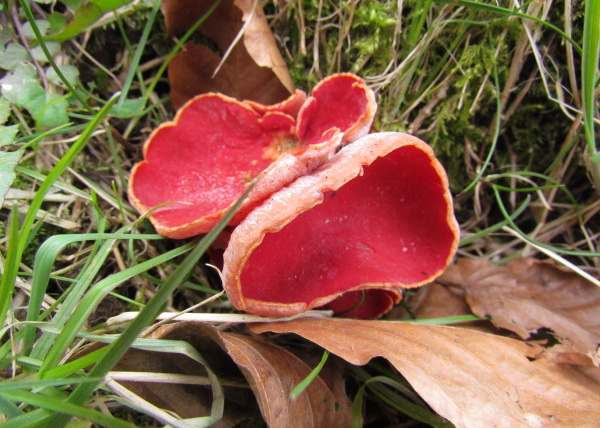
Sarcoscypha coccinea, the Ruby Elfcup (in common with the macroscopically almost identical Scarlet Elfcup Sarcoscypha austriaca) appears in winter on dead twigs in damp, shady places, usually partly buried in moss.
In recent years Sarcoscypha austriaca has been the more frequently recorded of the two red elfcup species in Britain and Ireland, whereas in the past Sarcoscypha coccinea was most commonly recorded. Difficulties in identification may be a significant factor in this, of course.
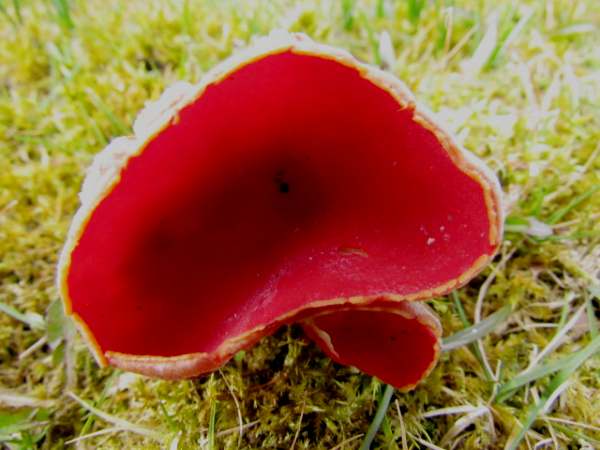
I have almost convinced myself that the Ruby Elfcup is usually a darker red than the Scarlet Elfcup, but as both species can vary considerably in colour from pale orange through to deep red it is simply not sensible to make colour part of the identification process. Ruby Elfcup fruitbodies rarely exceed 5cm across when fully expanded, whereas I have found Scarlet Elfcups more than 7cm across; however, the size overlap is such that again it is no real help in determining which of the two species you have found. A microscope is therefore the only way of being reasonably confident. Even then, it is much better to rely on measuring a set of features rather than gambling on a single observation. The spores of both of these species are elongated ellipsoids and, unfortunately, with a size overlap; however, some of the mature spores of Sarcoscypha austriaca produce conidial 'buds' which give their ends a hammerhead appearance, whereas the end of spores of Sarcoscypha coccinea are always rounded without budding protrusions.
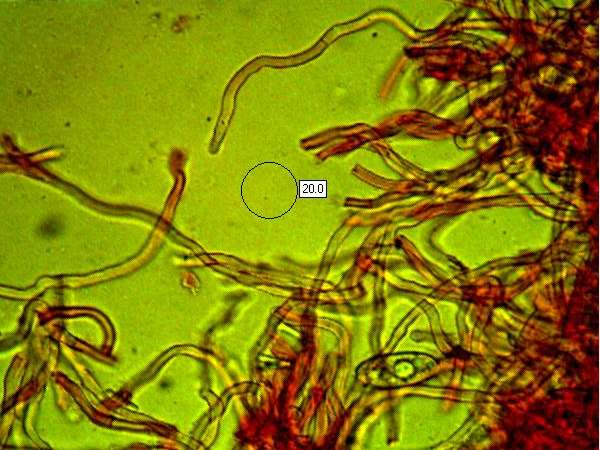
Another distinguishing feature is the hairy outer surface of the cups, which are covered in a matted felt (tomentum) of tiny uncoiled hairs in the case of Sarcoscypha coccinea and coiled (like a corkscrew) hairs in the case of Sarcoscypha austriaca.
Although distribution information for the two red elfcup species found in Britain goes back many decades, records prior to the turn of the present century may be seriously inaccurate as the distinction between various Sarcoscypha species (worldwide there are quite a few) was not clear until 1997, when American mycologist Francis A Hamilton et al. used molecular sequencing to infer the cladistic (evolutionary) relationships between the species within this difficult genus.
Above: Seen through a x400 microscope, the tiny hairs on the surface of a Ruby Elfcup are matted, but they are not coiled.
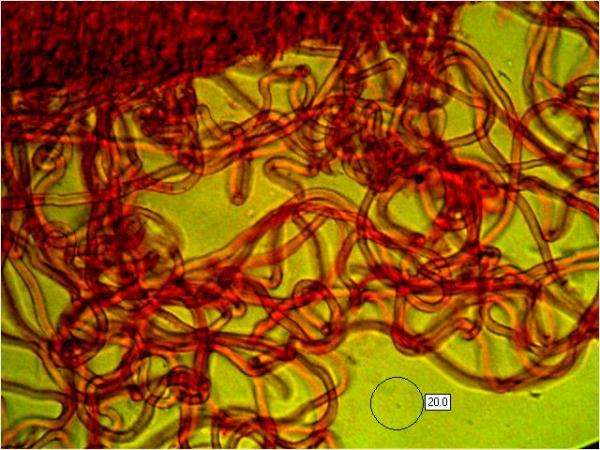
Here, for comparison purposes, is the corresponding photomicrograph for Sarcoscypha austriaca, the Scarlet Elfcup. With this species the hairs (tomentum) on the outer (infertile) surface of the cups are coiled rather than being straightish as they are for the Ruby Elfcup.
Some field guides refer to one or other of these two species having the longer stem, but in my experience the depth of moss through which they emerge from their buried timber substrate largely determines the stem length.
Another discriminating factor could be the substrate upon which these ascomycetes are feeding. Scarlet Elfcup is partial to a wide variety of hardood twigs including Sycamore, willows and Hazel. Ruby Elfcup is also a hardwood rotter, and it occurs on Beech and elms as well as Hazel. So both species can occur on Hazel... and rotten twigs are far from easy to identify to species level!
What all this says is that to be anywhere near certain which of the two red elfcup species you have found, microscopic study (unless you are equipped to carry out DNA analysis!) is probably the only option.
Distribution
Uncommon although reasonably widespread across Britain and Ireland, specially in areas of high rainfall, the Ruby Elfcup occurs also in many parts of mainland Europe, but it is rare in Mediterranean countries and southern parts of the Iberian Peninsula. This ascomycete fungus is also reported from parts of North America.
Taxonomic history
The species was described in 1755 by Carl Linnaeus, who called it Peziza cyathoides. It specific epithet (basionym) dates from 1774, when this cup fungus was described in Flora Austriaca by Netherlands-born botanist Nikolaus Joseph von Jacquin (1727 - 1817) under the scientific name Peziza coccinea. Sarcoscypha coccinea was given its current scientific name by Pier Andrea Saccardo in 1889.
The many synonyms of Sarcoscypha coccinea include Geopyxis coccinea (Jacq.) Sacc., Peziza insolita Cooke, Peziza cyathoides L., Peziza coccinea Jacq., Peziza epidendra Bull., Peziza aurantia Schumach., Macroscyphus coccineus (Jacq.) Gray, Geopyxis insolita (Cooke) Sacc., Helvella coccinea Schaeff., Geopyxis bloxamii Massee, and Aleuria insolita (Cooke) Boud.
Etymology
The specific epithet coccinea means 'bright red' (as in the edible colouring cochineal).
Identification guide
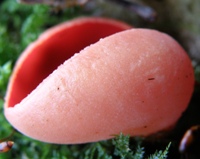 |
DescriptionThe irregularly shaped cups have a smooth, red (hymenal) inner surface and a much paler felty outer surface. The edge of young cups is usually incurved. There is a short stipe, typically 0.5-3cm long and 0.3-0.7cm diameter, often buried in moss and leaf litter, and it is the same colour as the outer surface of the cup or slightly paler. Cup diameter when mature ranges between 1.5 and 5cm; height (excluding stem) is typically 1 to 2cm. The outer (infertile) surface is paler than the inside, sometimes pinkish but often with an ochre tinge. It is covered in tiny hairs, some of which are straight while others have one or more bends, but they are not coiled as they are in Sarcoscypha austriaca. This is a useful identifying characteristic but requires strong magnification - please see the photomicrograph above. |
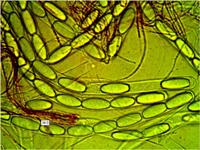 |
AsciCylindrical, typically 340 x 14µm.
|
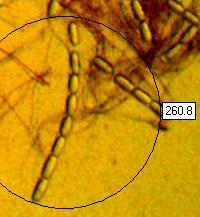 |
There are eight spores per ascus. |
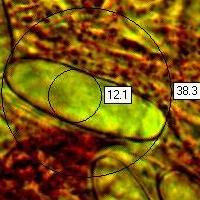 |
SporesElongated ellipsoidal (almost always with rounded ends), smooth, 26-40 x 10-12.5µm; hyaline. The oil droplets are distributed throughout the spores. Spore printWhite. |
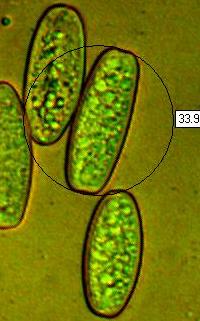 |
Spores observed within their ascus cannot be relied upon to give an indication of which of the two British red elfcup fungi you have found, and so if possible it is always better to do a spore print. Simply stand the cup, dark (fertile) side downwards on a microscope slide and place a drinking glass or other suitable container over it to prevent the fruitbody from drying out. If you can't see a fine white powder on the slide then use a razor blade to gather together whatever few spores have fallen onto the slide and then add a spot of Congo Red before placing a cover slip over the area. When I measured the spores from a sample collected with the group shown in the main picture (see to of page) their lengths ranged from 27 to 39µm - neatly centred on the average reported by modern field guides. The average width was about 12µm. All of the spores have rounded ends without conidial bud protrusions (asexual spores growing out from the ends of the sexual spores). |
Odour/taste |
Not distinctive. |
Habitat & Ecological role |
On fallen rotting hardwood twigs (especially hazel) usually buried beneath moss; very occasionally on moss-covered branches of dead standing trees in damp, shaded river valleys.. |
Season |
From spring through to late winter, but most abundant in the colder months. |
Similar species |
Sarcoscypha-austriaca, the Scarlet Elfcup, is virtually indistinguishable via macroscopic characters; it has coiled hairs on the outer (infertile) surface of the cup and broader spores often with flet ends or double-humped ends where conidial buds (asexual spores) are forning. Aleuria aurantia, the Orange Peel Fungus, is larger, orange rather than red, and grows on soil rather than on wood. |
Culinary Notes
The Ruby Elfcup and its close relative the Scarlet Elfcup are considered by some authorities edible as long as they are thoroughly cooked. (Lacking in flavour, their main culinary value must be in the splash of colour that they could add to a mushroom dish.) A few field guides now record these fungi as inedible, and some even suggest that they are 'suspect'; therefore we advise against gathering Ruby Elfcups and Scarlet Elfcups for eating.
Reference Sources
, Pat O'Reilly, 2016
BMS List of English Names for Fungi
Harrington F A. (1998). 'Relationships among Sarcoscypha species: evidence from molecular and morphological characters'. Mycologia 90 (2): 235–43.
Ruini, S., Ruedl, E. (1998). Un nuovo taxon di Sarcoscypha. S. austriaca var. lutea var. nov. Rivista di Micologia 4: 319-324.
Dictionary of the Fungi; Paul M. Kirk, Paul F. Cannon, David W. Minter and J. A. Stalpers; CABI, 2008
Taxonomic history and synonym information on these pages is drawn from many sources but in particular from the British Mycological Society's GB Checklist of Fungi.
Acknowledgements
This page includes pictures kindly contributed by Simon Harding.
Fascinated by Fungi. Back by popular demand, Pat O'Reilly's best-selling 450-page hardback book is available now. The latest second edition was republished with a sparkling new cover design in September 2022 by Coch-y-Bonddu Books. Full details and copies are available from the publisher's online bookshop...

